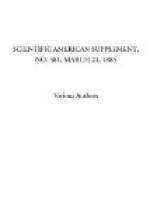H. C. O. N. Coke. Ashes. Density. Peat 5.63 57.03 29.67 2.09 —— 5.58 —— Lignite 5.59 70.49 17.2 1.73 49.1 4.99 1.2 Bitumin. coal 5.14 87.45 4 1.63 68 1.78 1.29 Anthracite 3.3 92.5 2.53 —— 89.5 1.58 1.3
Aside from the fact that anthracite is not met with solely in the lower coal measures, but is found in the middle and upper ones, and that bituminous coal itself is met with quite abundantly in the secondary formations, and even in tertiary ones, it seems to result from recent observations that if vegetable matter, when once converted into lignites, coal, etc., be preserved against the action of air and mineral waters by sufficient thick and impermeable strata of earth, preserves the chemical composition that it possessed before burial. The coal measures of Commentry, as well as certain others, such as those of Bezenet, Swansea, etc., contain quite a large quantity of coal gravel in sandstone or argillaceous rocks. These fragments sometimes exhibit a fracture analogous to that of ordinary coal, with sharp angles that show that they have not been rolled; and the sandstone has taken their exact details, which are found in hollow form in the gangue. In other cases these fragments exhibit the aspect of genuine shingle or rolled pebbles. These pebbles of coal have not been misshapen under the pressure of the surrounding sandstone, nor have they shrunk since their burial and the solidification of the gangue, for their surface is in contact with the internal surface of their matrix. Everything leads to the belief that they were extracted from pre-existing coal deposits that already possessed a definite hardness and bulk, at the same time as were the gravels and sand in which they are imprisoned. It became of interest, then, to ascertain the age to which the formation of these fragments might be referred, they being evidently more ancient than those considered above, which, as we have seen, could not have been transported in this state on account of their dimensions and the fragility of made coal. Thanks to the kindness of Mr. Fayol, we have been enabled to make such researches upon numerous specimens that were still inclosed in their sandstone gangue and that had been collected in the coal strata of Commentry. In some of their physical properties they differ from the more recent isolated fragments and from the ordinary coal of this deposit. They are less compact, their density is less, and a thin film of water deposited upon their surface is promptly absorbed, thus indicating a certain amount of porosity. Their fracture is dull and they are striped with shining coal, and can be more easily sliced with a razor.
From a fresh fracture, we find by the lens, or microscope, that some of them are formed of ordinary coal, that is, composed of plates of variable thickness, brilliant and dull, with or without traces of organization, and others of divers bits of wood whose structure is preserved. When reduced to thin, transparent plates, these latter show us the organization of the wood of Arthropitus, Cordaites, and Calamodendron, and of the petioles of Aulacopteris, that is to say, of the ligneous and arborescent plants that we most usually meet with in the coal measures of Commentry in the state of impression or of coal.




